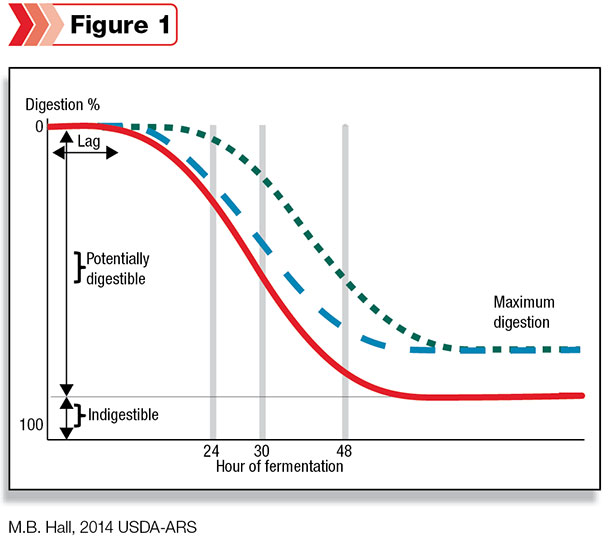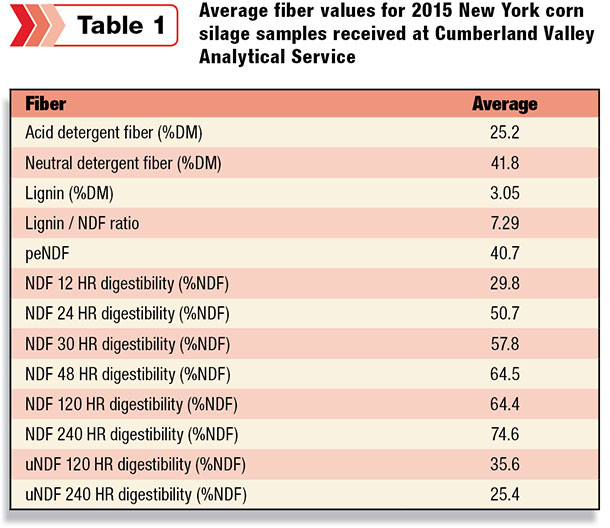The impact of fiber digestion on dairy nutrition is complex, and all the measurements of fiber digestion listed on the forage report add to the confusion. Understanding fiber digestion requires knowledge of what actually happens in the cow (in vivo) as well as why and how we try to estimate it in the laboratory (in vitro).
Most simply, when a cow eats fiber (NDF or neutral detergent fiber), part of it is fermented in the rumen for energy and microbial protein production (digestible NDF) and the other part ends up in the manure (indigestible NDF).
Let’s start in the rumen, which is where the majority of the fiber digestion occurs. Ruminal fiber digestion is diagrammed for three example forages in Figure 1.

When fiber enters the rumen, there is some period of time before the rumen bugs (bacteria and protozoa) can begin to break it down. This is known as the lag phase. The lag phase can be very short (minutes) or longer (hours) depending on the fiber composition of the plant material.
Once digestion begins, the easily digested part of the fiber disappears quickly; this is the “fast pool.” Next, the rumen bugs work on the more resistant material which digests more slowly. This is called the “slow pool.”
Although we separate these pools for calculation purposes, in the rumen their digestion overlaps with digestion of the slow pool, starting before digestion of the fast pool is complete.
Finally, there is a portion of the fiber that cannot be digested in the rumen, which is called the “indigestible pool.” In general, fiber digestion in the rumen is described as a four-phase decay curve: lag, fast pool, slow pool and indigestible pool.
Understanding fiber digestion is complicated by the fact that while the rumen bugs are trying to digest the fiber, there is competing passage out of the rumen.
This is a lot like a bathtub, where water is running in (intake), the drain is open (passage out) and the level of water determines residency time. Sometimes fiber particles that are highly digestible (beet pulp or soyhulls) may wash out before the bacteria can digest the fiber.
Passage rate out of the rumen will determine how much energy is actually derived from the fiber as well as how much space the fiber occupies. Unfortunately, measuring passage rate for a dairy ration is very difficult but has a large impact on estimates of digested fiber as well as the metabolizable protein produced by rumen bugs.
Almost all estimates of fiber digestion are conducted in the laboratory (in vitro) without the influence of passage rate or other real-world factors that can affect fiber digestion, such as an acidotic rumen.
Laboratory estimates of fiber digestion should be considered optimal values; actual digestion in the cow may be significantly lower. Table 1 shows the average values for corn silage fiber measurements conducted at Cumberland Valley Analytical Service in 2015.
Rumen fast pool
In general, the fast pool is estimated as the amount of NDF that disappears in 30 hours. Let’s continue to remind ourselves that this estimate is in a flask – with no passage and ideal rumen conditions. Historically, the fast pool was discussed as a percent of the NDF that disappears. This is usually written as DNDF.
In Table 1, the DNDF30 for 2015 corn silage samples from New York was 57.8 percent of the NDF. Because this measure does not account for total content of NDF, it is useful to evaluate the NDF quality but not cow performance. A better measurement is NDFd30, which is NDF disappearance expressed as a proportion of the dry matter.
For the samples in Table 1, the NDFd30 is 24 percent (41.8 percent NDF x 57.8 percent DNDF). The remaining NDF (18 percent of the dry matter) is considered undigested (NDFu30). NDFu30 will contain both the slow pool and the undigested pool.
We have suggested that forage NDFu30 content can be used as a measure of gut fill since average ruminal retention time is close to 30 hours. Particles which have not washed out or been digested after 30 hours contribute to gut fill.
While it is widely assumed that the fast fiber pool is estimated with a 30-hour incubation in the lab, this is not universal. Both 24-hour and 48-hour time points are also used to estimate the fast pool.
Obviously, the size of the fast pool changes with time point. Users need to be consistent in time-point selection to avoid adding error or confounding feed modeling programs.
Currently, most systems ignore the lag in fiber digestion. When working with total pool size, for example NDFd30, the lag is incorporated into the measure. However, when working with actual rates of digestion, lag becomes very important (Figure 1).
Some forages are slow to start digestion but then continue rapidly while others digest steadily. However, many examples can be found where forages with very different digestion rates have similar 30-hour DNDF values because of differences in the lag phase.
Rumen slow pool
The second phase of fiber digestion is the slow pool. The slow pool is estimated as the digestion between 30 and 240 hours. For the 2015 samples, the slow pool was 16.8 percent of the NDF (74.6 to 57.8).
Actual digestion of the slow-pool fiber in the cow is highly influenced by passage rate, which may flush the particles out of the rumen before the rumen bugs can digest them and generate metabolizable protein.
Rumen indigestible pool
To determine the forage energy potential, it is important to determine the indigestible portion of the fiber. Regardless of how long this material stays in the rumen, it will not degrade. The best current estimate of indigestible NDF is uNDF240. In the 2015 example, approximately 25 percent of the NDF is not digestible in the rumen. The Miner Institute recently reported that the intake of uNDF240 matches the manure excretion of uNDF240, providing support for the idea that uNDF240 does measure indigestible fiber.
Total tract digestion
Typically, fiber digestion measurements are used to predict fiber digestion in the rumen. However, to estimate total energy content of fibrous feeds, total tract fiber digestion must be known, since fiber digestion in the cecum and colon can contribute to the cow’s energy balance.
Dr. Combs at University of Wisconsin successfully used measurements of NDF digestion to estimate total tract NDF digestion for a better estimate of forage energy content.
Because the different phases of fiber digestion are additive and can overlap, many of the measurements are correlated. As a result, different ration evaluation platforms favor different measures. Further confusion arises when a single measure is touted as the “best” for describing fiber digestion.
In fact, the best measurement to use in a particular situation will depend on the biological process being estimated or modeled. For instance, estimating forage energy content depends on total tract fiber digestion, while an estimate of ruminal microbial protein production requires an estimate of ruminal fiber digestion calculated from digestion rates (percent per hour) and sizes of the fast and slow NDF pools (DNDF30 and DNDF240). PD
Joanne Siciliano-Jones, Ph.D., is with FARME Institute Inc.

-
Lawrence R. Jones
- American Farm Products Inc.
- Email Lawrence R. Jones






